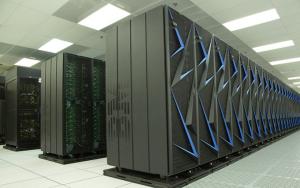LAB REPORT
Science and Technology Making Headlines
July 26, 2019


LLNL researchers Richard Kraus, Arthur Pak, Daniel Casey and Félicie Albert are recipients of the highest honor bestowed by the U.S. government on early career scientists and engineers – the prestigious Presidential Early Career Award for Science and Engineers.
A presidential honor
Four scientists from Lawrence Livermore National Laboratory have been selected to receive the prestigious Presidential Early Career Award for Science and Engineering, or PECASE.
Félicie Albert, Daniel Casey, Richard Kraus and Arthur Pak are among 315 recipients nationwide who will be honored in a ceremony in Washington, D.C. later this year.
Established in 1996, the PECASE acknowledges the contributions scientists and engineers make to the advancement of their respective fields, according to the Lab.


A single wafer process chamber used by Applied Materials to perform physical vapor deposition on any type of wafer, including the sapphire substrates used in the HPC4Manufacturing collaboration with Lawrence Livermore National Laboratory. Photo courtesy of Applied Materials.
Thin LEDS see the light
Lawrence Livermore researchers are working with semiconductor chip manufacturer Applied Materials to improve a process for depositing thin-film materials on wafers that are used in high-efficiency LED lights and other products.
Reliably creating thin films with favorable electrical, optical, structural and chemical properties is an important problem in manufacturing. One possible technique for depositing thin films with controlled properties is high-powered impulse magnetron sputtering (HiPIMS), which has yet to be optimized because modeling magnetron plasma discharges at relevant densities is a “grand challenge computing problem,” researchers said.
Magnetron sputtering involves repeatedly bombarding a “target” with high-density plasma (containing ions and electrons), causing material to break from the target and “sputter” onto a substrate, such as a silicon wafer. In HiPIMS, a variant of magnetron sputtering, the plasma is typically high-energy and pulsed. The main advantage to HiPIMS, researchers said, is that they can ionize more of the sputtered material, giving them better control over uniformity and density of the resulting film.


Livermore Graduate Scholar and chemist Fanny Chu is part of a team that found that any single hair from anywhere on the human body can be used to identify a person.
Hanging on by a hair
Building on a novel forensic approach that analyzes proteins in head hair, scientists from Lawrence Livermore’s Forensic Science Center (FSC) and Michigan State University have established that it's possible to identify a person from a single hair taken from anywhere on the human body.
The best-known test for a positive identification is DNA, but DNA in hair only comes from particular parts of the strand with the rest made up largely of a fibrous protein known as keratin and, according to the researchers of the new study, contains only minimal intact nuclear DNA. Worse, the material is highly vulnerable and liable to break down.
However, hair protein provides a wide spectrum of amino acid markers that can be detected by mass spectrometry and can survive for up to 250 years. In 2016, scientists from the FSC developed a test based on hair proteins from a single strand of head hair, but for the method to be practical, it needs to be applied to hairs from anywhere else on the body. For sexual assault cases, pubic hairs are especially important.
According to the team, a statistical analysis of the markers can tell where on the body the hair came from with the protein content of pubic hair significantly higher than head and arm hair. In addition, new amino acid markers have been found that make the method more accurate. Where it originally could pick one person out of a million, it can now use a single one-inch strand to pick one person out of 10 million.


Switchgrass is used as a biomass crop for advanced biofuel production
Powered by switchgrass
Plant cell walls contain a renewable, almost limitless supply of sugar that can be utilized in the production of chemicals and biofuels. But retrieving these sugars is not all that simple.
Imidazolium ionic liquid (IIL) solvents are one of the best sources for extracting sugars from plants. However, the sugars from IIL-treated biomass are inevitably contaminated with residual IILs that inhibit progress in bacteria and yeast, blocking biochemical production by these organisms.
Lawrence Livermore National Laboratory scientists and collaborators at the Joint BioEnergy Institute have identified a molecular mechanism in bacteria that can be controlled to promote IIL tolerance and overcome a key hole in biofuel and biochemical production processes.


Lawrence Livermore National Laboratory’s Lassen joined its companion system Sierra in the top 10 of the TOP500 list of the world’s most powerful supercomputers. Lassen leaped to No. 10 while Sierra stayed at No. 2
Populated by petaflops
The latest Top500 list of the world’s most powerful supercomputers shows that petaflop systems dominate the landscape.
The TOP500 project is a bi-annual report on supercomputers around the world based on the High-Performance Linpack (HPL) benchmark. For the first time since its inception in 1993, only petaflop systems have made the TOP500 computer list.
Livermore has two supercomputers in the top 10 on the list. Sierra, a classified system used for stockpile stewardship, sits at No. 2 with a maximum performance of 94.6 petaFLOPs (94.6 quadrillion point operations per second).
Lassen, an unclassified, heterogenous IBM/NVIDIA system with the same architecture as Sierra but smaller, placed No. 10 on the list with a benchmark score of 18.2 petaFLOPs boosting its original 15.4 petaFLOP performance from last November.





